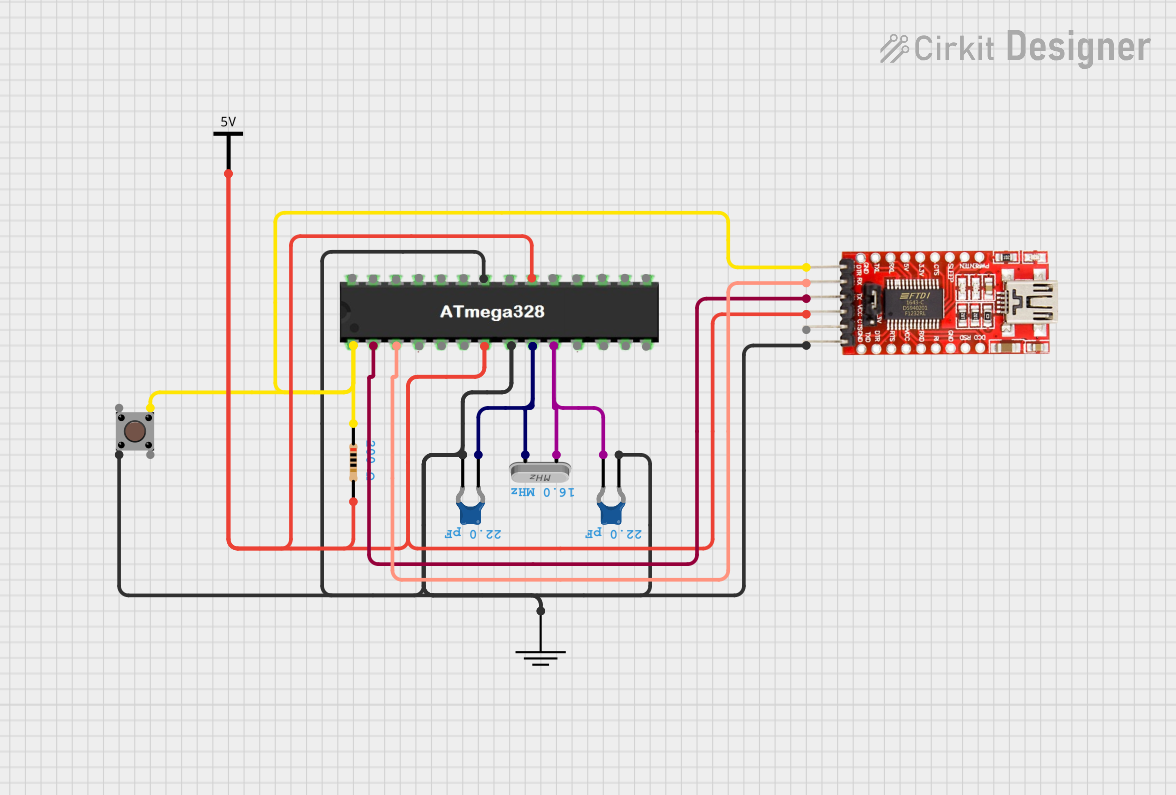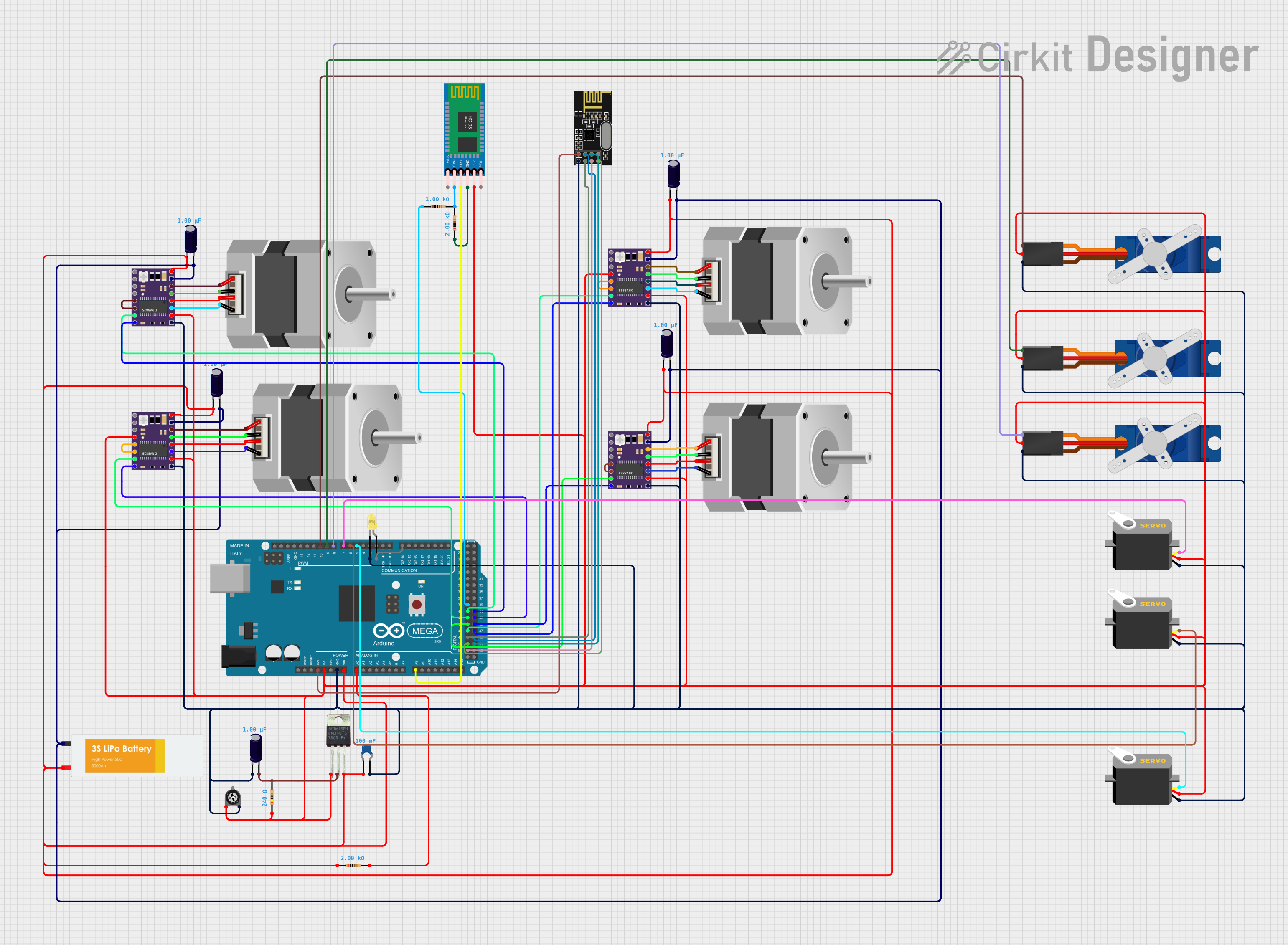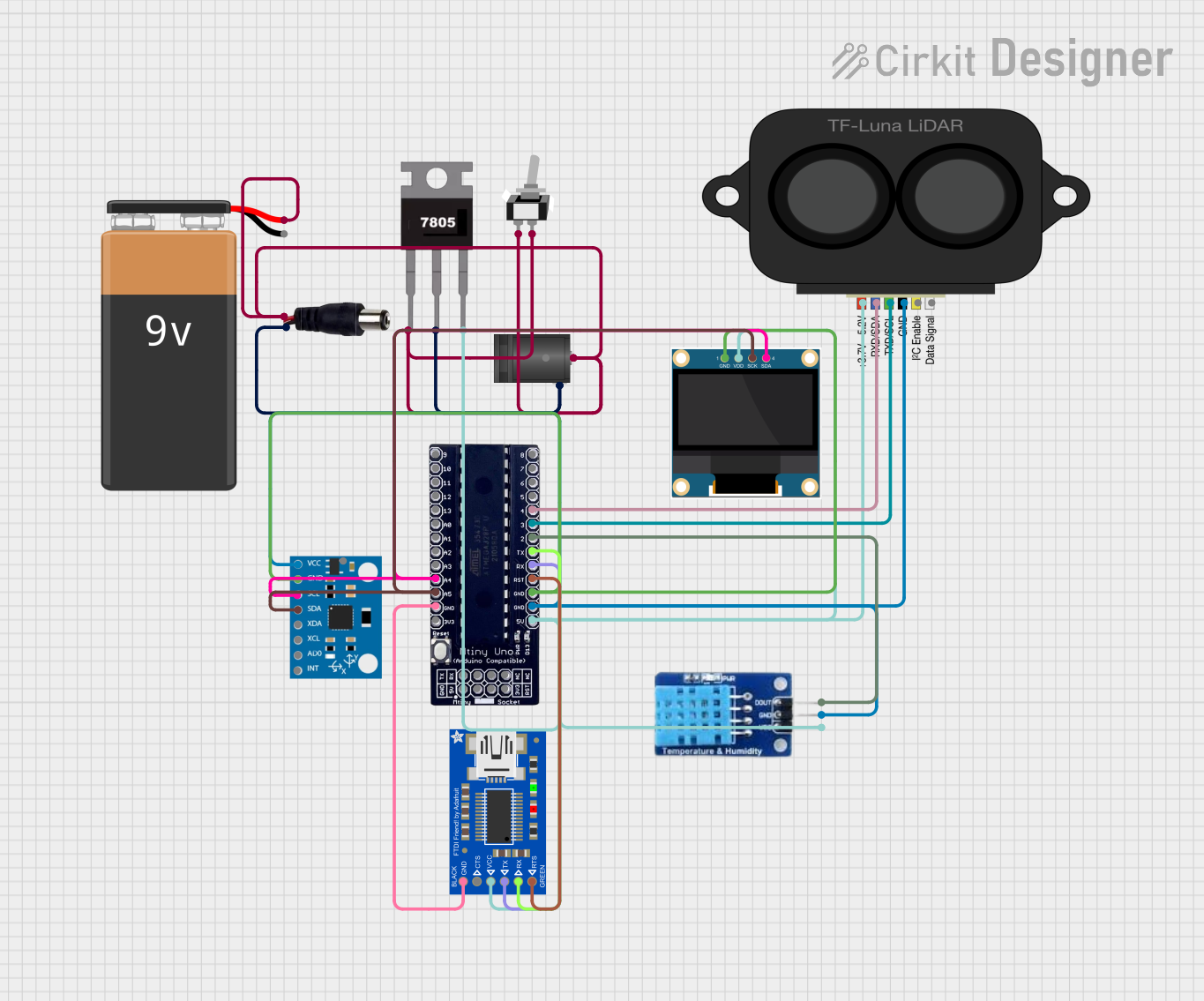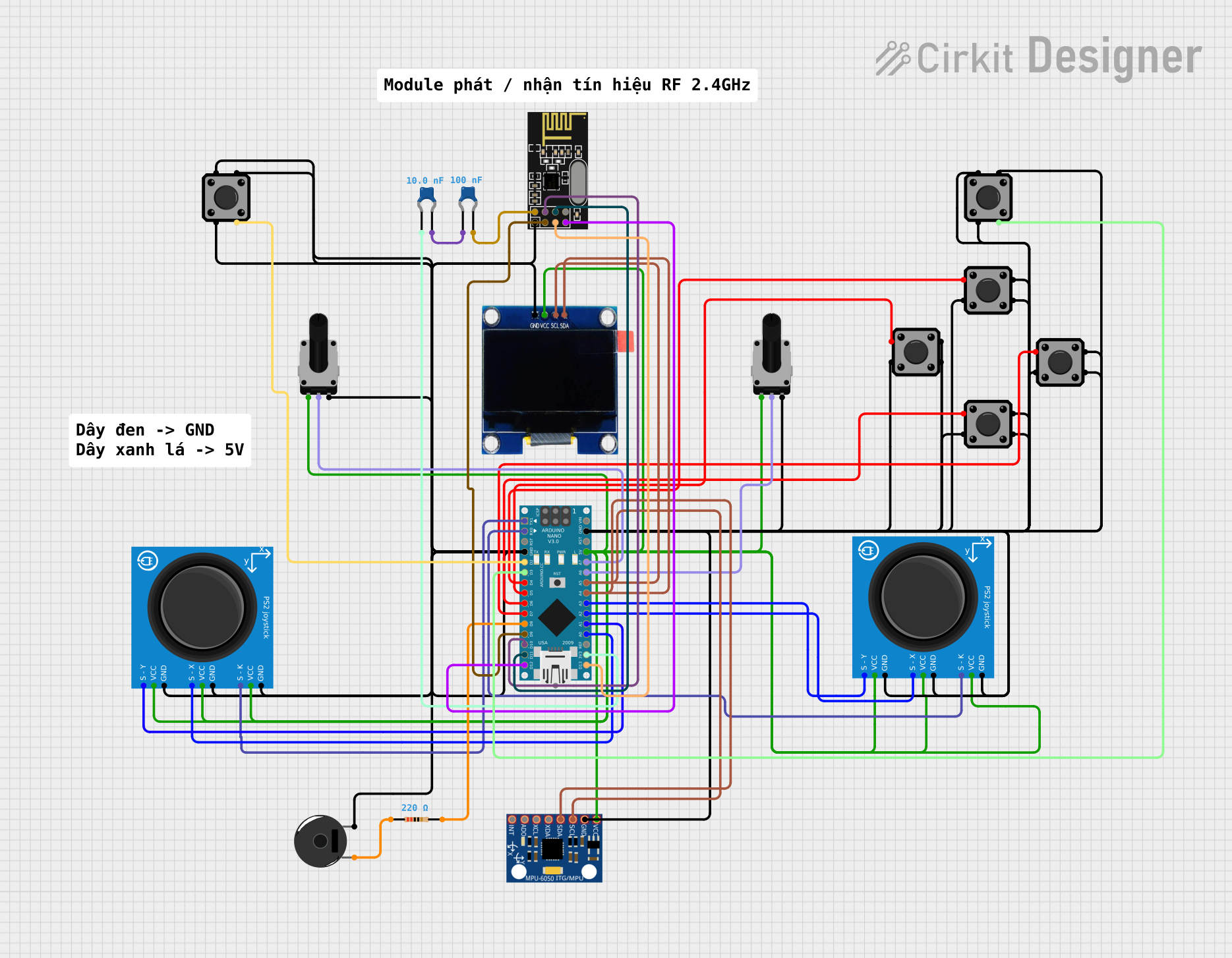
How to Use atmega644pa: Examples, Pinouts, and Specs

 Design with atmega644pa in Cirkit Designer
Design with atmega644pa in Cirkit DesignerIntroduction
The ATmega644PA is an 8-bit microcontroller from Atmel's AVR family, designed for high-performance and low-power applications. It features 64KB of flash memory, 4KB of SRAM, and 32 general-purpose I/O pins, making it a versatile choice for embedded systems. With its rich set of peripherals, including timers, ADCs, and communication interfaces, the ATmega644PA is widely used in applications such as industrial automation, home automation, robotics, and IoT devices.
Explore Projects Built with atmega644pa

 Open Project in Cirkit Designer
Open Project in Cirkit Designer
 Open Project in Cirkit Designer
Open Project in Cirkit Designer
 Open Project in Cirkit Designer
Open Project in Cirkit Designer
 Open Project in Cirkit Designer
Open Project in Cirkit DesignerExplore Projects Built with atmega644pa

 Open Project in Cirkit Designer
Open Project in Cirkit Designer
 Open Project in Cirkit Designer
Open Project in Cirkit Designer
 Open Project in Cirkit Designer
Open Project in Cirkit Designer
 Open Project in Cirkit Designer
Open Project in Cirkit DesignerCommon Applications:
- Embedded systems and control applications
- Robotics and motor control
- IoT devices and smart home systems
- Data acquisition and processing
- Prototyping and educational projects
Technical Specifications
The ATmega644PA offers a robust set of features tailored for a variety of applications. Below are its key technical specifications:
Key Features:
- Architecture: 8-bit AVR RISC
- Operating Voltage: 1.8V to 5.5V
- Flash Memory: 64KB
- SRAM: 4KB
- EEPROM: 2KB
- Clock Speed: Up to 20 MHz
- I/O Pins: 32 general-purpose I/O pins
- Timers: Two 8-bit and two 16-bit timers
- ADC: 10-bit, 8-channel ADC
- Communication Interfaces: USART, SPI, I2C (TWI)
- Power Consumption: Low-power modes available (Idle, Power-down, etc.)
- Package Options: 40-pin PDIP, 44-pin TQFP, 44-pin QFN
Pin Configuration:
The ATmega644PA has 40 pins in the PDIP package. Below is the pin configuration and description:
| Pin Number | Pin Name | Description |
|---|---|---|
| 1 | VCC | Power supply voltage |
| 2 | GND | Ground |
| 9 | RESET | Reset input (active low) |
| 10 | XTAL1 | Input to the inverting oscillator amp |
| 11 | XTAL2 | Output from the inverting oscillator amp |
| 14-21 | PORTB[0-7] | General-purpose I/O or SPI interface |
| 22-29 | PORTC[0-7] | General-purpose I/O or ADC inputs |
| 30-37 | PORTD[0-7] | General-purpose I/O or USART interface |
| 38 | AVCC | Analog power supply |
| 39 | AREF | Reference voltage for ADC |
| 40 | GND | Ground |
For a complete pinout and alternate functions, refer to the ATmega644PA datasheet.
Usage Instructions
The ATmega644PA is a versatile microcontroller that can be used in a variety of circuits. Below are the steps and best practices for using it effectively:
Basic Circuit Setup:
- Power Supply: Connect VCC to a regulated power source (1.8V to 5.5V) and GND to ground.
- Clock Source: Use an external crystal oscillator (e.g., 16 MHz) connected to XTAL1 and XTAL2, along with appropriate capacitors (typically 22pF).
- Reset Pin: Connect a 10kΩ pull-up resistor to the RESET pin to ensure proper operation.
- I/O Pins: Configure the I/O pins (PORTB, PORTC, PORTD) as input or output in the software.
Programming the Microcontroller:
The ATmega644PA can be programmed using an ISP (In-System Programmer) or a bootloader. Below is an example of programming it with an Arduino UNO as an ISP:
Arduino UNO as ISP:
- Connect the ATmega644PA to the Arduino UNO as follows:
- MISO (Pin 18): Connect to Arduino pin 12
- MOSI (Pin 17): Connect to Arduino pin 11
- SCK (Pin 19): Connect to Arduino pin 13
- RESET (Pin 9): Connect to Arduino pin 10
- VCC and GND: Connect to Arduino 5V and GND
- Upload the "ArduinoISP" sketch to the Arduino UNO.
- Use the Arduino IDE to burn the bootloader or upload a program to the ATmega644PA.
Example Code:
Below is an example of blinking an LED connected to PORTB0:
// Define the LED pin
#define LED_PIN 0 // PORTB0 is pin 0 on PORTB
void setup() {
// Set PORTB0 as an output
DDRB |= (1 << LED_PIN); // Set bit 0 of DDRB to 1
}
void loop() {
// Turn the LED on
PORTB |= (1 << LED_PIN); // Set bit 0 of PORTB to 1
delay(500); // Wait for 500ms
// Turn the LED off
PORTB &= ~(1 << LED_PIN); // Clear bit 0 of PORTB
delay(500); // Wait for 500ms
}
Best Practices:
- Use decoupling capacitors (e.g., 0.1µF) near the VCC and AVCC pins to reduce noise.
- Avoid leaving unused pins floating; configure them as inputs with pull-up resistors or as outputs.
- Use proper ESD protection when handling the microcontroller.
Troubleshooting and FAQs
Common Issues:
Microcontroller Not Responding:
- Cause: Incorrect power supply or clock configuration.
- Solution: Verify the power supply voltage and ensure the crystal oscillator is properly connected.
Program Upload Fails:
- Cause: Incorrect ISP connections or fuse settings.
- Solution: Double-check the ISP wiring and ensure the correct fuse bits are set.
ADC Not Working:
- Cause: AVCC or AREF not connected.
- Solution: Connect AVCC to VCC and AREF to the desired reference voltage.
I/O Pins Not Functioning:
- Cause: Pins not configured correctly in the software.
- Solution: Verify the pin configuration in the code.
FAQs:
Q: Can the ATmega644PA run at 3.3V?
- A: Yes, the ATmega644PA can operate at 3.3V, but the maximum clock speed will be limited to 10 MHz.
Q: How do I enable the internal pull-up resistors?
- A: Set the corresponding pin as an input and write a logic HIGH to the pin. For example:
DDRB &= ~(1 << PINB0); // Set PORTB0 as input PORTB |= (1 << PINB0); // Enable pull-up resistor on PORTB0
- A: Set the corresponding pin as an input and write a logic HIGH to the pin. For example:
Q: What is the maximum current per I/O pin?
- A: Each I/O pin can source or sink up to 40mA, but the total current for all pins should not exceed 200mA.
By following this documentation, users can effectively utilize the ATmega644PA in their projects and troubleshoot common issues. For more detailed information, refer to the official datasheet.